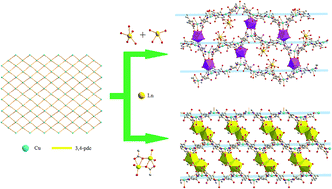Two series of novel 3D potentially porous heterometallic Cu–Ln coordination frameworks assembled by 3,4-pyridinedicarboxylic acid with different topologies and channels: syntheses, structures, luminescence and magnetic properties†
Abstract
Self-assembly of rare earth salts, Cu(NO3)2 and 3,4-pyridinedicarboxylic acid (3,4-pdcH2) resulted in the formation of two series of 3 d–4f heterometallic coordination polymers: [Ln2Cu3(3,4-pdc)6(H2O)12]·mH2O·nCH3OH (Ln = Eu (1, m = 22, n = 0), Gd (2, m = 22, n = 0) and Tb (3, m = 15.5, n = 5)) and [LnCu(3,4-pdc)2(OAc)(H2O)3]·8H2O (Ln = Ho (4), Er (5)). Their structures have been determined by single-crystal X-ray diffraction analyses and further characterized by elemental analyses, IR spectra, PXRD and TGA. The structures of isomorphous complexes 1–3 (Form I) are constructed with irregular (4,4)-connected 2D [Cu3(3,4-pdc)6(H2O)3]n sheets pillared by Ln(H2O)4, showing an intriguing 3D 36·418·53·6 framework with the treatment of the Ln2Cu3 unit as an 8-connected node. Complexes 4 and 5 (Form II) are constructed with (4,4)-connected 2D [Cu(3,4-pdc)2(H2O)]n sheets pillared by bimetallic units Ln2(OAc)2(H2O)4, exhibiting a fascinating 3D architecture with (4,8)-connected fluorite (412·612·84)(46)2 topology. There exist different 1D channels in the polymers of Form I and Form II, in which solvent molecules are accommodated. Moreover, their luminescence and magnetic properties have been investigated.


 Please wait while we load your content...
Please wait while we load your content...